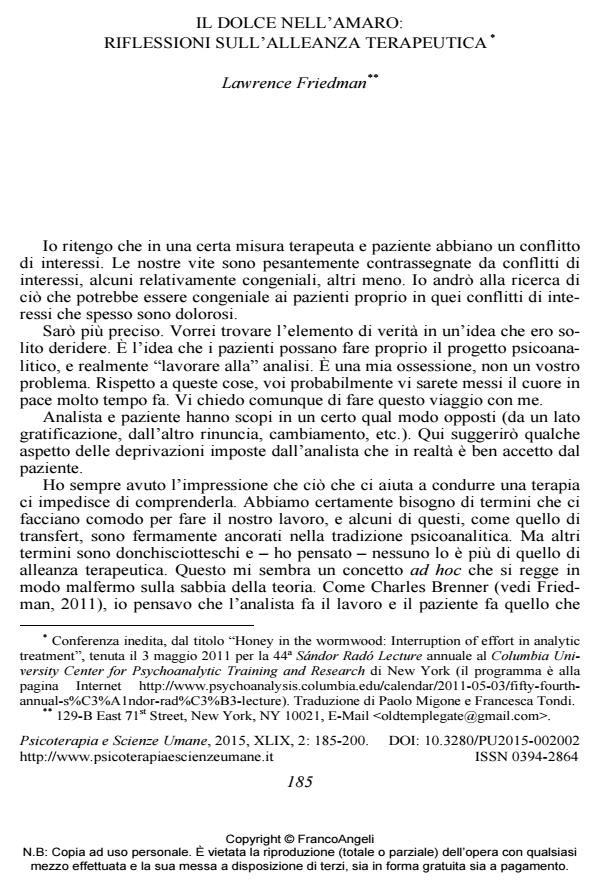Il dolce nell’amaro: riflessioni sull’alleanza terapeutica
Titolo Rivista PSICOTERAPIA E SCIENZE UMANE
Autori/Curatori Lawrence Friedman
Anno di pubblicazione 2015 Fascicolo 2015/2
Lingua Italiano Numero pagine 16 P. 185-200 Dimensione file 66 KB
DOI 10.3280/PU2015-002002
Il DOI è il codice a barre della proprietà intellettuale: per saperne di più
clicca qui
Qui sotto puoi vedere in anteprima la prima pagina di questo articolo.
Se questo articolo ti interessa, lo puoi acquistare (e scaricare in formato pdf) seguendo le facili indicazioni per acquistare il download credit. Acquista Download Credits per scaricare questo Articolo in formato PDF

FrancoAngeli è membro della Publishers International Linking Association, Inc (PILA)associazione indipendente e non profit per facilitare (attraverso i servizi tecnologici implementati da CrossRef.org) l’accesso degli studiosi ai contenuti digitali nelle pubblicazioni professionali e scientifiche
Viene esaminato il concetto di alleanza terapeutica ponendo la domanda se vi sia un lavoro specificamente psicoanalitico che possa essere eseguito consciamente dal paziente in modo tale che si possa dire: "Il paziente sta veramente lavorando per essere analizzato". La sfida è quella di identificare quel tipo di lavoro del paziente che collabora con la specifica azione della psicoanalisi. Viene proposto che la caratteristica che distingue qualitativamente la psicoanalisi dalle altre terapie verbali è l’interruzione dello sforzo del paziente. Allo scopo di immaginare un incentivo che un paziente può avere per schierarsi dalla parte della propria frustrazione, vengono prese in rassegna alcune immagini di sforzo e di interruzione. Un tentativo di risposta ha a che fare col valore del viaggio nel tempo.
Parole chiave:Tempo, azione terapeutica della psicoanalisi, alleanza terapeutica, cornice della psicoterapia, costruzione sociale della realtà
- Is there a Usable Heidegger for Psychoanalysts? Lawrence Friedman, in Journal of the American Psychoanalytic Association /2016 pp.587
DOI: 10.1177/0003065116655085 - Ruoli affettivi, compiti e decisioni Alfio Maggiolini, in PSICOTERAPIA E SCIENZE UMANE 1/2017 pp.75
DOI: 10.3280/PU2017-001005
Lawrence Friedman, Il dolce nell’amaro: riflessioni sull’alleanza terapeutica in "PSICOTERAPIA E SCIENZE UMANE" 2/2015, pp 185-200, DOI: 10.3280/PU2015-002002